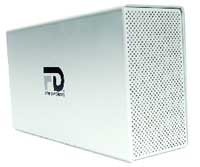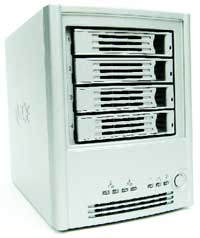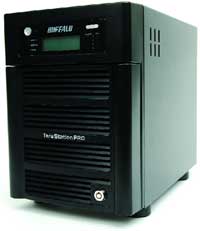Fast drives, easy setup, rackmount design. Expensive. A+ A B+ C+The Snap Server 410 we eventually tested performed well in all areas.However, in the interest of fairness, we should disclose that the first 410 we brought into the lab did not work and had to be replaced.Our original test unit was a 2T model with a retail price of $3,295, which is manageable but a little on the pricey side. The replacement 410, however, was only a 640G unit with a price of $1,995. There are much better and lessexpensive ways to add 640G to your network, so the value score suffered.Assuming you are buying one of the higher-capacity 410 models, the rackmount format might be perfect for your needs. Simply slide it into a 1U spot in your server room, and you are just about ready to go. After hooking up power and a network cable, you can go to the computer you want to use as a manager and install the Snap software. You only have to install the software once, because it will discover any other Snap servers as you add them.The server is smart and will grab a free IP address, assuming you have enabled DHCP and have a free slot in your scope. By the time we had installed the software, the 410 was set to use.The management interface on the 410 is good at letting you know what's going on inside the server. It presents a lot of information, such as whether it used a DHCP server to find its IP or had one assigned, the health of the drive, any potential warnings, and, of course, how much space is used and how much is free.If anything is not working correctly, the software will help you pinpoint the problem quickly.The GuardianOS it runs on is designed to be secure, which is a nice feature. You probably don't want yet another Windows operating system for some hacker to exploit. You can pretty much set up the 410 and forget it if that is what you want to do.As an option, you can get your 410 with CA eTrust Antivirus. The 410 also can be set to RAID 0, RAID 1 or RAID 5. Ours defaulted to RAID 0, which was a good thing given that our test file was 400M.The 410 wrote quickly to the disk, finishing the test file in 3 minutes, 5 seconds, the best time in the review. It erased the file in 1 minute, 1 second, also the fastest time here.The Snap Server 410 is speedy and easy to set up but expect to pay for the premium performance.Adaptec, (800) 442-7274, www.snapserver.com No real setup procedure needed. Worked only intermittently during our testing, no real user controls, nostatus display. B- B- C CThe GForce NAS Megadisk is built like a little brick and ' at first ' was only slightly more functional.Supposedly, you can simply plug the device in to your network and turn it on, whereupon it shows up in your network ready to provide 1T of storage capacity. It even has a rating of E for Easy on the box ' but in our experience, it was more like E for Exacting.When we plugged in the Megadisk and connected to the network, it did not seem to do anything other than illuminate a red-and-blue light in the front of the airflow grille. It did not show up on our test network, and the DHCP server showed no record of it trying to obtain an IP address.With poor documentation and no status screen, we could not diagnose the problem. Eventually we tried a factory reset, which can be triggered by inserting a paper clip into a recessed hole in the back of the unit. The only other control is an on-and-off switch. The lights came on again, but still nothing happened. We powered down the unit and went home for the night.The next day, before we kicked it out of the review, we powered it one more time. This time it worked, though we have no idea why or what was preventing it from working before.There was no software in our box, just the user manual, which is pretty sparse. According to the specs, there is a single Serial Advanced Technology Attachment drive in the metal housing, though it's not designed for user access.In terms of speed, it was not bad, writing a 400M file in 4 minutes, 30 secondsand erasing it in 1 minute, 43 seconds.For just $369, you might be tempted to add a GForce to your network, but we would advise against it. It might be fine for a home user. But in a government network, the intermittent performance, relatively low capacity and lack of any management controls mean it might cause more trouble than it's worth.Micronet Technology, (800) 980-3463, www.fantomdrives.com Detailed management features, easy installation, very high capacity. Extremely slow to implement changes, difficult software interface. B C+ A AThe LaCie Ethernet Disk RAID comes in a square housing that is popular now for small storage servers. It was easy to install, but working with it got harder after that.After plugging in the network cable, we ran the installation software, a process necessary if this is the first LaCie drive you set up. The included software was out-of-date and needed to be upgraded. After the upgrade, it was able to detect the Ethernet Disk RAID device, which had smartly found our DHCP server and acquired an IP address. This one step added 4T of storage to our test network for a reasonable price of $2,299.The LaCie drive is designed for intricate management, letting you control what individual users and groups are allowed to access and how much space is available to them. Unfortunately, the drive makes some odd decisions by default, and changing them is both difficult and time-consuming as you wait for the drive to respond to commands. The problem was severe enough to lower the ease-of-use and performance grades.For example, when you set up a public folder, it defaults to a size of 194M, which is smaller than our 400M test file. But there is no option to change the default size of a folder as it's being created, which would be the optimal time.Instead, you have to create the folder and go to the Advanced tab along the horizontal management interface. This brings up several choices running vertically down your screen. You then select the Drives option from the list and, finally, the Expand Storage Folders option. We selected the Use All Available Space for Public Storage option, and the LaCie began to implement our change ' for the next two hours.You are locked out of the management interface while the system makes your changes. We were told we would be directed back into the management interface when the changes were complete but were given no indication of how long that would take. It took 1 hour, 56 minutes. We thought the unit had broken down.Another odd choice, though this did not affect the grade, was that the default drive configuration was RAID 5+Spare. This means that three of the drives are actually in use, with stripes of data being pulled from each one and stored in the others so if any drive fails, you can bring back your data most of the time.However, this reduces the capacity of the three working drives by about a third. The fourth drive does nothing at all, simply sitting at the bottom of the housing as a spare in case another one fails.This cuts your storage down to 1.8T, not a small decrease for a 4T unit. You could instead set up a RAID 1 configuration with full backup and almost 2T of storage space or a RAID 0 configuration using all the capacity with no backup.We think most users will want to pick an extreme and not the odd middle ground with a spare doing nothing.The transfer speeds on the LaCie drive were neither speedy nor terribly slow. It took 5 minutes, 25 seconds to write the 400M test file to the drive and 3 minutes, 15 seconds to erase it.That's not bad ' if you don't count the two hours we waited for the public storage folder to grow to a usable size. Also, the screen indicated during most of the time in the erasing test that the LaCie was preparing to delete and not pulling data back off the drive.We have no idea why the LaCie needs so much time to prepare to perform what should be a simple process.If you want to intricately manage your storage, then the LaCie Ethernet Disk RAID is the choice for you. It also offers a huge capacity jolt for your network if you change the default setting from RAID 5+Spare to RAID 0.LaCie, (503) 844-4500, www.lacie.com/us Large capacity, good value, easy to use. Nothing significant. A- A+ A+ AThe TeraStation Pro II from Buffalo Technology is a perfect example of what easy network storage should be. There are different configurations, depending on your size needs.The one we tested had 2T of storage capacity and a list price of $1,199, which was quite reasonable given the amount of space available. The TeraStation looks like a little square box and is designed ' with its flat top and rubber feet ' to be stacked if necessary.Once you attach a network cable, you need to run the setup software on a PC in your network, assuming this is the first TerraStation you have installed. The software will find the new storage server and let you configure it, though we did not have to do anything to ours other than create a network shortcut for our speed tests.The default configuration on our unit was RAID 1, which halves the storage capacity but gives you complete redundancy. Two of the four Serial ATA drives hold data, and the other two back everything up from the primary ones. Losing even a complete drive in this case does not cause any data loss. You can also reconfigure the drives to RAID 0, RAID 5 or RAID 10.The first thing you will notice about the TeraStation is that it has a fairly large LCD window at the top of the housing, the only server in the review to have one. The display tells you exactly what is going on inside the TeraStation, what your RAID level is, what disks are being accessed and the overall health of the drive. There is a lot of information on the panel, which is great if you're not near the PC you use to monitor your storage network. Many functions can be changed locally.And if you happen to have a bunch of TeraStations, Buffalo accounted for the possibility that they could get lost in a sea of storage by including a function called 'I'm here!' on the software console. When you activate it, the TeraStation you are connecting to plays a little song and its front panel begins blinking. So when you need to replace a drive or work with a specific unit, finding it is easy even if it's sitting alongside several identical ones.Helpful functions like this earned the TeraStation the highest marks for ease of use.In terms of raw speed, the TeraStaion was quick but not blazingly fast. It could write our 400M test file to the drive in 4 minutes, 23 seconds. Removing the file took 2 minutes, 28 seconds.And here we found yet another interesting feature: When you delete a file, it does not go directly to the recycle bin on the management computer. Instead, the TeraStation creates a new folder called Trash Box and puts the file there. Anything in the box can be restored to full size. If you then delete items in the trash box or the trash box folder, the data is erased.It takes just as long to move files to the on-drive trash box as it does to delete them permanently, which is a little odd. Some people might find the trash box annoying, but we liked the extra step to prevent accidentally deleting important documents.There is nothing we really didn't like about the TeraStation. It offers lots of easy-to-use features, good capacity and a great price.It's what most people want in a storage server and, as such, earns our Reviewer's Choice designation.Buffalo Technology, (800) 456-9799, www.buffalotech.com
Nearly every aspect of computing these days contributes to huge file sizes. With storage fairly cheap and programs shipping on high-capacity DVDs, there is no real
incentive for programmers to reduce application bloat, so spaghetti programming is alive and well.
Even small devices contribute to the problem, such as digital cameras that sometimes default to taking high-resolution photos of 10M or more. And don't get us started on the size of multimedia files. The result is that it does not take long to fill even large drives.
Network administrators are particularly vulnerable to file-size increases, because
multiple users contribute to filling all available capacity on the servers they are trying to manage.
Short of draconian file-size restrictions or regular, mass trashing of files, there is not much you can do with a standard network to make sure everyone has enough storage capacity.
The answer in many situations could be network-attached storage, sometimes simply called storage servers. Think of these devices almost as appliances.
They are basically a set of high-capacity drives with limited intelligence that can find a spot on your network, set themselves up and be made ready for use by simply plugging in a network cable and booting them up. At least, that's how they work in the technicians' fantasyland where all of us who churn through network problems every day would like to live.
But in reality, even simple storage devices sometimes aren't so simple. We tested four storage servers, and although several offer good performance or useful features, only one ' the TeraStation Pro II ' worked perfectly right out of the box.
The others experienced problems ranging from a convoluted interface that required hours for even simple changes to the inability to find the Dynamic Host Configuration Protocol server, odd default Redundant Array of Independent Disk configurations, and simple and complete inoperability.
Given the problems we experienced, it's no surprise that the key criterion for these simple devices was ease of use or the lack thereof. The speed of file transfers both onto and off the drive was also a factor, which we tested using a 400M file folder.
Any extra features a unit had were also important but counted only half as much as ease of use. Finally, we compared everything to the price to arrive at the value grade.
 Adaptec Snap Server 410SNAP STYLE: The Adaptec Snap Server 410 slides easily into a 1U rack and had the fastest write times in the review.Pros:Con:
Adaptec Snap Server 410SNAP STYLE: The Adaptec Snap Server 410 slides easily into a 1U rack and had the fastest write times in the review.Pros:Con:










